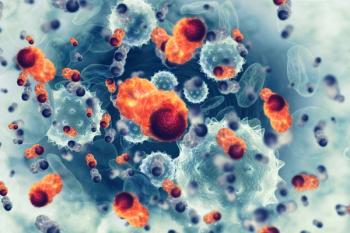
- Oncology Vol 28 No 4_Suppl_1
- Volume 28
- Issue 4_Suppl_1
(S041) The Effect of High-Dose Stereotactic Body Radiation Therapy on Liver Function in the Treatment of Primary and Metastatic Liver Malignancies Utilizing the Child-Pugh Score Classification System
Evaluation of liver function following high-dose liver stereotactic body radiation therapy (SBRT) in the treatment of metastatic and primary malignancies of the liver utilizing the Child-Pugh score classification system.
Pawel T. Dyk, MD, Shahed N. Badiyan, MD, Robert Myerson, MD, Parag Parikh, MD, Jeffrey R. Olsen, MD; Washington University
Purpose: Evaluation of liver function following high-dose liver stereotactic body radiation therapy (SBRT) in the treatment of metastatic and primary malignancies of the liver utilizing the Child-Pugh score classification system.
Materials and Methods: Retrospective analysis of 46 patients treated with SBRT for metastatic and primary malignancies of the liver. Patient, disease, prior treatment, and SBRT dosimetric factors were analyzed to correlate with decline in Child-Pugh score following liver SBRT.
Results: Median follow-up was 11.0 months for patients alive at last follow-up. Twenty-four patients (52%) had primary liver malignancies. Median delivered dose was 55 Gy in 5 fractions (range: 36–60 Gy in 3–6 fractions) to 1 lesion (1–4 lesions) measuring 4.0 cm (range: 1.3–12.4 cm). Forty-one patients (89%) received ≥ 50 Gy in 3–6 fractions. Child-Pugh score classification was A in 42 patients (91%). Seven patients (15%) received adjuvant chemotherapy or targeted therapy. Twenty-nine patients (63%) experienced an intrahepatic recurrence following treatment. Ten patients (22%) experienced a decline in Child-Pugh score at a median time of 1.6 months (range: 0.2–6 mo). Eighty percent experienced a one-category decline. Only the V20, V25, V30, and V50 were correlated with decline in Child-Pugh score on univariate analysis, with V25 being most significant (P = .027). A V25 > 32% was associated with a 41% incidence of Child-Pugh score decline, compared with 10% for V25 ≤ 32 (P = .021). For primary liver malignancies, a V25 > 36% was associated with a sevenfold increase in the incidence of Child-Pugh score decline (70% vs 10%; P = .006).
Conclusions: Approximately one-quarter of patients experience a decline in Child-Pugh score following high-dose liver SBRT. The V25 may be an important dosimetric parameter predicting decline in liver function following treatment.
Proceedings of the 96th Annual Meeting of the American Radium Society -
Articles in this issue
Newsletter
Stay up to date on recent advances in the multidisciplinary approach to cancer.


















































































